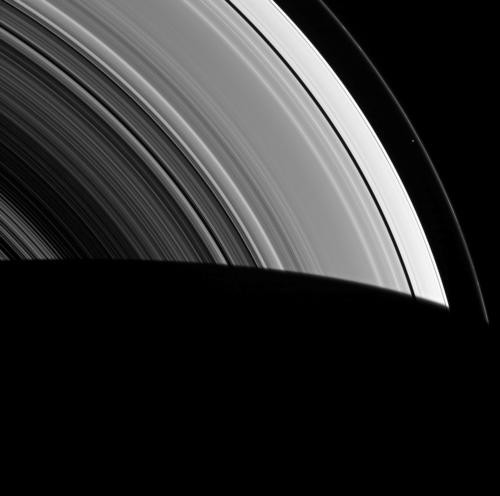Exoplanet's Massive Rings are as Large as a Solar System
| Marco Foronda | | Jan 27, 2015 05:37 AM EST |
(Photo : NASA/JPL-Caltech/Space Science Institute) The small dot located in Saturn's outer F-ring is Prometheus, a moonlet the size of a mountain.
A new study reveals the existence of an exoplanet whose ring system is as large as an entire solar system.
The planet is called J1407b and was first discovered in 2012 but was only recently studied in great detail. It lies roughly 430 light years away from our solar system.
Like Us on Facebook
J1407b's ring system is the first of its kind to be discovered outside of the solar system. Its ring system is roughly 200 times larger than Saturn's rings. Researchers estimate that its mass is roughly 40 times heavier than Jupiter.
The research discovered over 30 individual rings, each one tens of millions of miles in diameter. Between each concentric ring are gaps that suggest the presence of exomoons or satellites similar to the many moons that shape Saturn's rings.
"We see the rings blocking as much as 95 percent of the light of this young Sun-like star for days, so there is a lot of material there that could then form satellites," said co-author Eric Mamajek of the University of Rochester, New York
He also estimates there is some 1-Earth mass-worth of finely ground material inside J1407b's rings.
Researchers were detected the exoplanet's ring system without seeing them. They used the same methods astronomers use to locate new alien worlds, which is detecting light variation in stars as their planets orbit and eclipse them.
"The star is much too far away to observe the rings directly, but we could make a detailed model based on the rapid brightness variations in the star light passing through the ring system. If we could replace Saturn's rings with the rings around J1407b, they would be easily visible at night and be many times larger than the full moon," explained lead study author Matthew Kenworthy, an astronomer at the Leiden Observatory in The Netherlands.
Details of the new study were published in the Astrophysical Journal.
Tagsalien planet, J1407b, solar system, Jupiter, Saturn's rings, exoplanet, space exploration, Galaxy, new planet
©2015 Chinatopix All rights reserved. Do not reproduce without permission
EDITOR'S PICKS
-

Did the Trump administration just announce plans for a trade war with ‘hostile’ China and Russia?
-

US Senate passes Taiwan travel bill slammed by China
-

As Yan Sihong’s family grieves, here are other Chinese students who went missing abroad. Some have never been found
-

Beijing blasts Western critics who ‘smear China’ with the term sharp power
-

China Envoy Seeks to Defuse Tensions With U.S. as a Trade War Brews
-

Singapore's Deputy PM Provides Bitcoin Vote of Confidence Amid China's Blanket Bans
-

China warns investors over risks in overseas virtual currency trading
-

Chinese government most trustworthy: survey
-

Kashima Antlers On Course For Back-To-Back Titles
MOST POPULAR
LATEST NEWS
Zhou Yongkang: China's Former Security Chief Sentenced to Life in Prison

China's former Chief of the Ministry of Public Security, Zhou Yongkang, has been given a life sentence after he was found guilty of abusing his office, bribery and deliberately ... Full Article
TRENDING STORY

China Pork Prices Expected to Stabilize As The Supplies Recover

Elephone P9000 Smartphone is now on Sale on Amazon India

There's a Big Chance Cliffhangers Won't Still Be Resolved When Grey's Anatomy Season 13 Returns

Supreme Court Ruled on Samsung vs Apple Dispute for Patent Infringement

Microsoft Surface Pro 5 Rumors and Release Date: What is the Latest?










